Since 1999, British diesel and electric locomotives have worked in various parts of Europe for a variety of reasons. In this definitive and exclusive feature Anthony Sayer tells the story of what worked where and when – and what locos are still abroad.
I was recently asked the following question: How many British main-line diesel and electric locomotives have worked abroad?
Having made numerous trips into Europe over recent years, I knew that there have been ‘quite a few’ but I couldn’t be absolutely specific. So I set about producing a list of such locomotives and, at the same time, tried to understand the reasoning behind their deployment abroad.
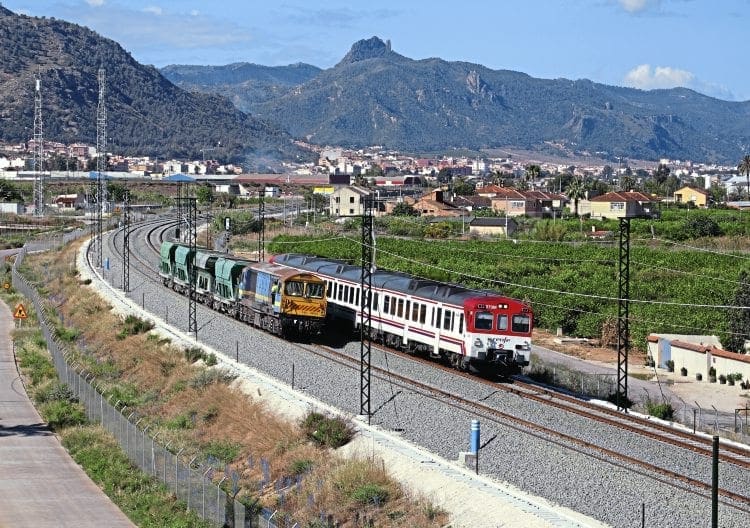
Extensive research, combined with personal observations, has uncovered a surprisingly complex subject, in particular the precise scoping of the topic: do you include locomotives which have moved abroad but which have not actually worked in revenue-earning service (e.g. spare parts donors, exhibition locomotives, equipment for testing, etc)?; do you include locomotives built abroad and subsequently imported for use in the UK (eg: Class 56 (56001-30), 59, 66, 67, 68, 70 and 88)?; do you include locomotives built abroad (and, therefore, not technically British) but subsequently exported for use abroad after a period of use in the UK (e.g. Class 66s in France and Poland)?; and, should you include the Class 92s operating between Dollands Moor (UK) and Calais Fréthun (France)?
Monthly Subscription: Enjoy more Railway Magazine reading each month with free delivery to you door, and access to over 100 years in the archive, all for just £5.35 per month.
Click here to subscribe & save
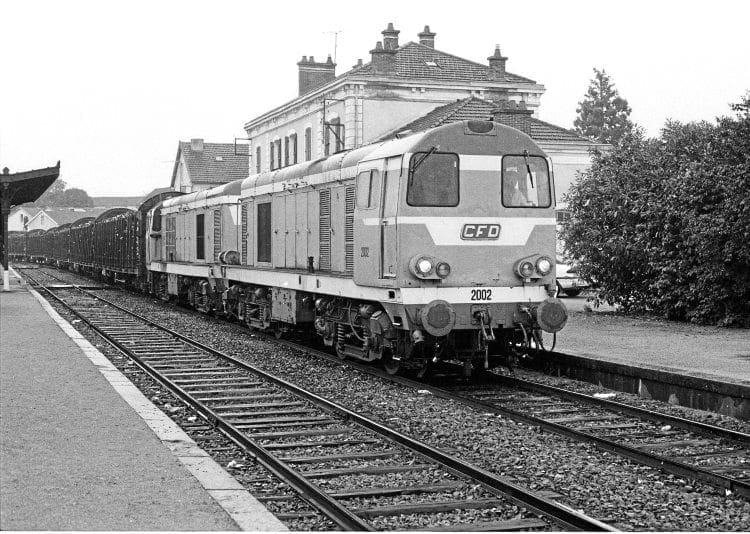
For the purposes of this article, main-line diesel and electric locomotives which have worked extensively in the UK prior to shipment abroad (and, therefore, considered to have been British assets) are included, irrespective of where they were originally built. Locos sent abroad for spares donor purposes to support the active fleets are also included. However, Class 92s deployed on Channel Tunnel operations are excluded.
January 1999 has been used as the start point for the statistical analysis on the basis that this year saw the start of volume-usage of British locomotives abroad.
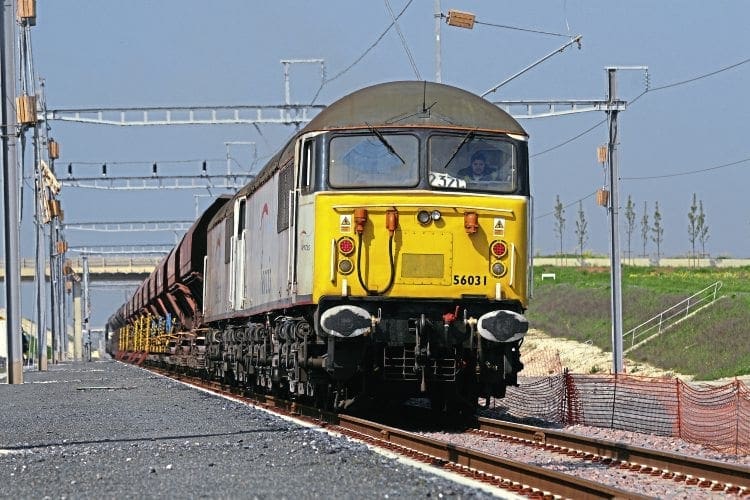
Since the beginning of 1999 no fewer than 277 British main-line locomotives have spent time abroad. Within this number, 12 have managed to have had operating bases in two European countries. Today there are 182 main-line British locomotives resident abroad (plus one in preservation – Werkgroep 1501’s E27003), with another two Class 92s pending.
Pre-1999 moves
The earliest transfer of a British main-line diesel or electric locomotive abroad was LNER No. 6000 (subsequently E26000 Tommy). This locomotive was loaned to the Dutch railways over the period 1947-52.
Other early transfers of British locomotives abroad represented the isolated sales of redundant assets. For example: seven Class 77 (E27000-6) electric locomotives to the Netherlands in 1969; the unique HS4000 Kestrel to Russia in 1971; and five Class 14 diesel-hydraulic locomotives to Belgium in 1975 (D9505/34) and Spain in 1982 (D9515/48/9).

Class 20s were deployed on Channel Tunnel tracklaying work during 1992/93 and 20 of the class were bought and hired out by RFS for this purpose.
The locomotives concerned were Nos. 20001/47/8/56/84/8/95, 20102/5/7/8/13/20/7/33/45/59/66/75/94, but there is conflicting evidence as to whether all 20 actually worked from the French end of the tunnel and therefore constituted British traction abroad.
Three electric locomotives – Nos. 89001, 90008 and 91003 – spent time in Germany during June 1988 at the International Railway Exhibition in Hamburg. In addition, Nos. 92001 and 92002 moved to the Czech Republic and Austria during 1994/95 for static and mobile testing as part of their extended pre-introduction preparations.

Already abroad in 1999
Moving onto the period covered by this article (1999 to date), BR sold four Class 20 diesel-electric locomotives to CFD (Compagnie de Chemin de Fer Départementaux [subsequently CFD Industrie]) that exported them to France (via Poole and Cherbourg) in July 1992, following overhaul at BREL Crewe Works.
These locomotives were based at Autun and operated freight trains on the Cravant Bazarnes-Avallon-Saulieu-Autun-Etang-Montchanin route in Central France.
The locomotives were numbered 2001-4 and painted in a distinctive orange livery. They returned to the UK in August/September 2005 via Southampton after a number of years of declining use following the purchase of CFD Industrie by SNCF subsidiary VFLI.
Also abroad was Foster Yeoman No. 59003, exported to Germany in May 1997 and operated by Yeoman/Deutsche Bahn hauling stone trains.
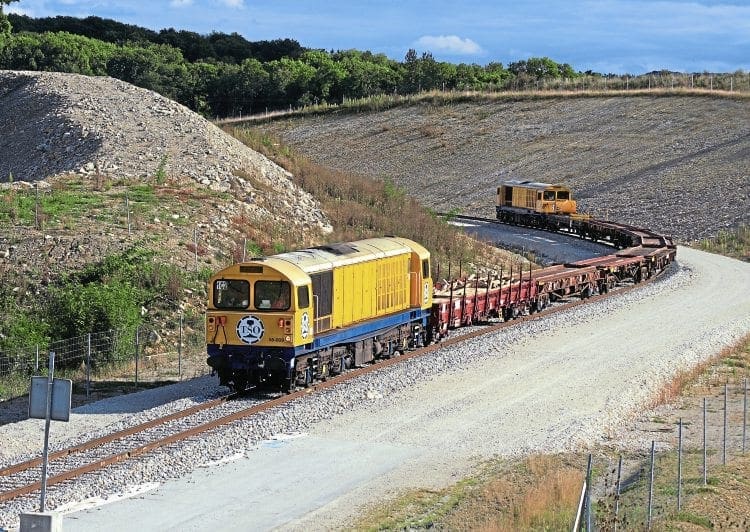
It was sold in 2001 to HHPI (Heavy Haul Power International). No. 59003 continued to carry its cast numberplates (even though its operating number was 259 003) and Yeoman Highlander nameplates throughout its period in Germany.
In August 2014, it was bought by GBRf and returned to the UK via Immingham Dock in October 2014.
So, five British locomotives were working abroad at the start of 1999, but things were about to change!
Summary (end-1998):
■ CFD-20035/63, 20139, 20228 (4)
■ Foster Yeoman/DB (subsequently HHPI) – 59003 (1)
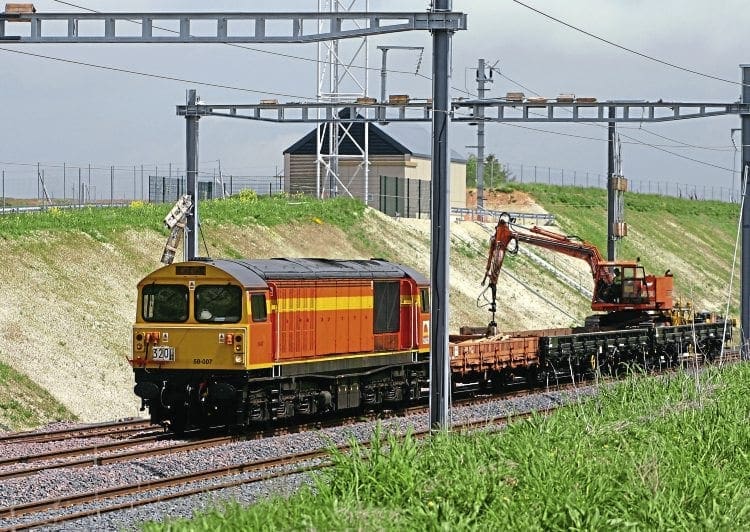
Humanitarian Twenties
DRS (Direct Rail Services) locomotives Nos. 20901-3 were sent from the UK to Kosovo in September 1999 as part of the ‘Train for Life” movement, with the Class 20s actually hauling the train in parts of the transit through Europe. The Train for Life provided humanitarian aid for the Kosovan people following the Kosovo War.
In addition, the Class 20s were deployed on trains in Kosovo until December 1999 in support of the UN/KFOR (United Nations/ Kosovo Protection Force) aid work. The three Class 20s were returned to the UK in April 2000.
Summary:-
■ DRS (UN/KFOR) – 20901-3 (3)
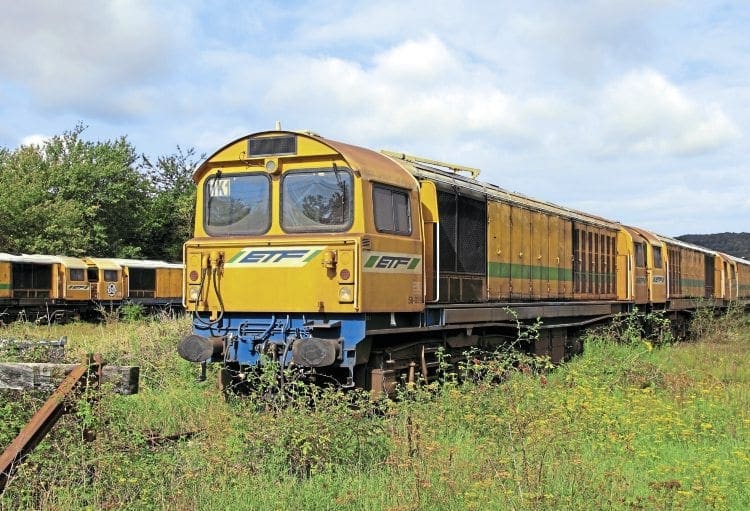
HSL Construction
However, it was the expansion of high-speed line (HSL) construction in mainland Europe that really sparked the movement of British locomotives abroad in any volume, earning useful revenue from otherwise redundant assets.
During the period June to September 1999, EWS (English, Welsh & Scottish Railway) moved 40 Class 37 locomotives to France, via the Channel Tunnel, to assist with the construction of the LGV (Ligne à Grande Vitesse) Méditerranée from Valence to Marseilles.
These were followed by a further two in May 2000, replacing two unserviceable locomotives. These were all based at Eurre and operated on the St Marcel-les-Valence to Orange section of the construction trace. All of the 42 retained their motley selection of British liveries while in France.

Watching the evening convoy of Class 37s with their rakes of ballast hoppers thrashing their way up to Tartaguille tunnel as they returned to base was a memory that will never be forgotten. All locomotives were returned to the UK between July and October 2000, many never to work again.
In the following year, 2001, EWS moved 14 heavyweight Class 37/7s to Spain (via the Channel Tunnel) for use on AVE (Alta Velocidad Española) construction work between Madrid and Barcelona. The locomotives were hired by Continental Rail, a subcontractor to GIF (Gestor de Infraestructuras Ferroviarias), the body with overall responsibility for the construction of new lines in Spain.
The 14 Class 37s initially operated from bases at Calatyud and Salilas de Jalón. Interestingly two locomotives (37800/88) had previously worked abroad on the French LGV Méditerranée project.
Over the ensuing years, the Class 37s moved progressively east towards Barcelona and ultimately on towards Figueres on the Spanish/French border, being variously based at Puigverd de Lleida, Alcover, Vilafranca del Penedès, Hostalric and Llers.
Locomotives were supplied in the GIF light-blue livery; while some locomotives were repainted in Spain, all retained the light blue colours throughout. Continental Rail L-series numbers were applied in the range L21-34.
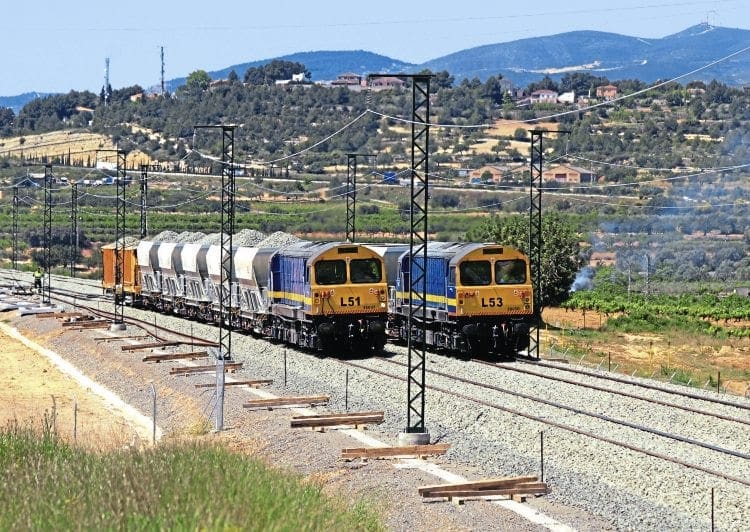
Time and accidents took their toll on the Spanish Class 37s and ultimately only six returned to the UK in August 2012, the remainder (37702/99, 37801/2/83/5/8/99) being disposed of in Spain. In fact, accident damage to three Class 37s early on led to the export of 58041/3 to cover activities at Calatyud and Puigverd de Lleida, in 2003/4.
Italy was the home for two EWS Class 37s between July 2001 and March 2003. This pair was hired to Italian company CEAAV and deployed on HSL (high-speed line) construction work between Capua (north of Napoli) and Ceprano (south of Rome) on the Milan-Rome-Napoli route.
The locos were progressively based at Capua, Tora e Piccilli and Ceprano. Both locomotives carried the EWS maroon/gold livery and their UK numbers while in Italy. Work was completed by mid-2002 and given the unlikelihood of further work were returned to the UK for further use in 2003.
The next major European high-speed construction project involving British traction was the LGV Est line in France between Vaires-sur-Marne (near Paris) and Baudrecourt (near Metz). Work started at the St Hilaire base and nine Class 56s and 14 Class 58s were moved through the Channel Tunnel during the period September to November 2004. A further four Class 56s arrived at St Hilaire in April/May 2005.
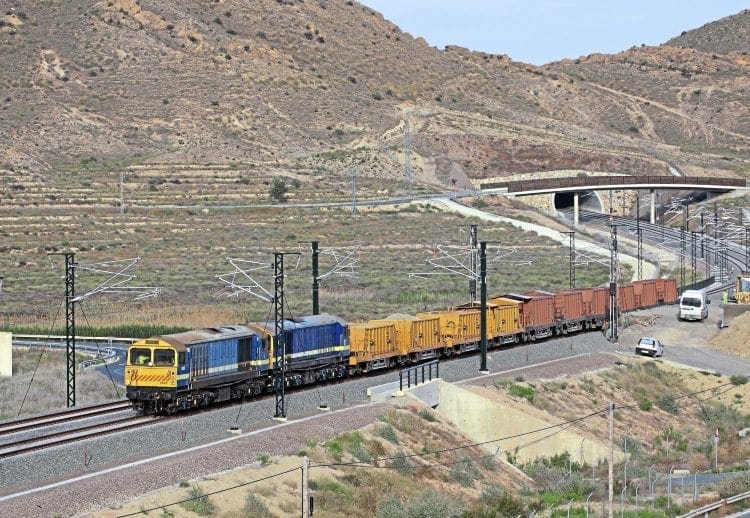
As work drew to a close at St Hilaire, the Class 56s and 58s were redeployed at two bases at Ocquerre and Pagny-sur-Moselle, being joined by a further 17 Class 56s and five Class 58s.
In the end, 49 EWS locomotives (30 Class 56s and 19 Class 58s) operated on the LGV Est line. The locomotives were ‘sectorised’ and carried appropriate liveries to reflect their operators – 41 were operated by Fertis (predominantly for ballast trains), four by TSO and four by Seco (predominantly for tracklaying work), although towards the end they tended to become general user locomotives on the trace. All locomotives returned to the UK.
The French LGV Rhin-Rhône project followed in 2009, with 24 (now DB Schenker) Class 58s moved to the Villersexel base between June and November 2009 for construction work between Villers-les-Pots (near Dijon) to Les Petit Croix (near Belfort).
This included the three otherwise redundant Dutch ACTS Class 58s, which were transferred direct to France without returning to the UK (see below). Interestingly, of the 24 Class 58s deployed on the LGV Rhin-Rhône project, 14 had previously operated on the LGV Est line.
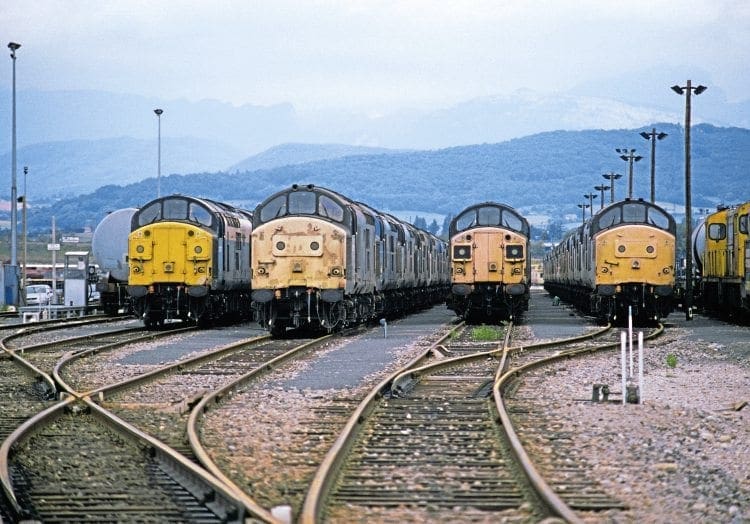
The 24 Class 58s were painted in all-over yellow livery, with 12 carrying ETF decals (and green waist-line stripe) and 12 carrying TSO embellishments.
On completion of work in late 2010, the 24 Class 58s were booked to move to Alizay for safe storage pending further LGV contract work; in the event, 23 arrived at Alizay, but one currently resides at Woippy Yard, near Metz, with wheelset issues.
Spanish AVE construction work continued apace during the mid-2000s, with the Class 37s progressively moving eastwards towards Barcelona.
However, work on the Codoba-Malaga extension in 2004-06 saw the export of six further EWS Class 58s to Spain, shipped via Newport Docks and Seville in May 2004.

These, together with the now relocated Nos. 58041/3, operated from Bobadilla base (near Antequera), and subsequently Almodóvar Del Rio (near Córdoba) and Los Prados (near Málaga). No. 58031 also worked on the Madrid-Valladolid AVE line, based at Olmedo during 2007.
These eight locomotives were subsequently moved to Albacete in 2008 for use on the Madrid to Albacete AVE line, some being outbased at Gabaldón. Four additional Class 58 locomotives moved via the Channel Tunnel in September 2008 to join the fleet, initially based at Requena Utiel for work on the extension to Valencia.
The first eight Class 58s were delivered to Spain in GIF light blue livery, as per the Class 37s, but were subsequently repainted into the darker blue Continental Rail livery with a yellow waist band, following GIF’s succession by ADIF (Administrador de Infraestructuras Ferroviaria, the infrastructure arm of national railway operator RENFE)).
The final four locomotives (58015/27/47/50) were delivered in the later colour scheme. Continental Rail L-series numbers were applied (see table).
In 2012, nine of the fleet were transferred to Transfesa ownership. These nine continued to see use on the AVE construction work, based at Monforte del Cid, for the Albacete to Alicante extension, and subsequently in 2015/16 on the ‘branch’ from Monforte del Cid to Murcia.The three retained by DB Schenker were stored at Albacete and remain there to this day.
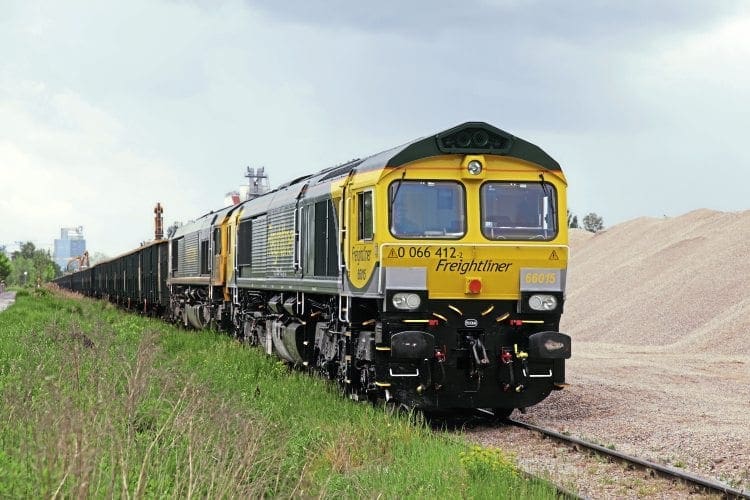
Six Class 58s based at Monforte del Cid are currently applying the finishing touches to the Murcia branch and the La Encina triangle, with the remaining three stored (two at Monforte del Cid and one at Albacete alongside the three remaining DB members of the fleet).
Summary:-
■ LGV Méditerranée – 37010/37/46/58/69/71/3/4/7, 37100/33/46/62/70/96, 37221/38/50/61/93/4/8, 37376, 37510/3/5, 37671/2/83/5/6/93/6, 37708/96, 37800/3/88/90/1/4/6 (42)
LGV Est (Phase 1) – 56007/18/31/2/8/49/51/8-60/5/9/
71/4/8/81/7/90/1/4-6, 56103-6/13/5/7/8 (30),
58004/7/9-11/5/6/8/21/7/32-5/40/6/7/9/50 (19)
■ LGV Rhin-Rhône – 58001/4-7/9-11/3/8/21/6/
32-6/8-40/2/4/6/9 (24) N.B. 58038/9/44 had previously worked for ACTS in the Netherlands and 58004/7/9/10/1/8/21/32-5/40/6/9 had previously worked in France (LGV Est).
■ AVE Spain – 37702/3/14/6/8/99, 37800-2/83-5/8/99 (14) N.B. 37800/88 has previously operated in France (LGV Méditerranée). 58015/20/4/5/7/9-31/41/3/7/50 (12). N.B. 58015/27/47/50 had previously worked in France (LGV Est).
■ Italy -37893/5 (2)
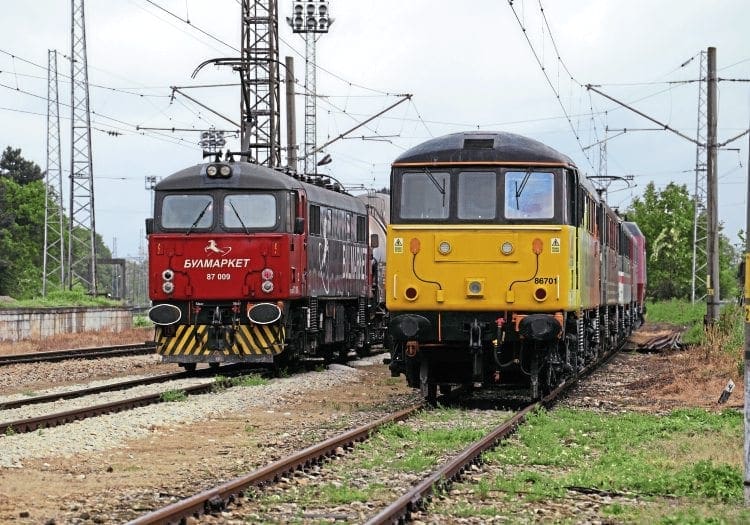
Triple Dutch
During 2003, EWS hired three otherwise redundant Class 58s to Dutch private operator ACTS. Five locomotives were originally envisaged, but only three actually migrated across the Channel.
The locomotives were prepared at Toton (including the fitting of modified light clusters), and renumbered 5811 (58039), 5812 (58044) and 5814 (58038); 5811 and 5812 were repainted into the ACTS blue & yellow scheme, while 5814 was repainted into Vos Logistics black & red colours.
No. 5811 arrived in Holland in June 2003, followed by 5812 in October 2003; 5814 subsequently arrived in May 2005. All were shipped out via Immingham Docks. The Class 58s were deployed on container services, with a heavy concentration on the so-called ‘Veendam Shuttles’.
ACTS stopped using the Class 58s in March 2009. The three locos were repainted into the ETF yellow livery at the RET workshops at Rotterdam Hillgersberg, and were then moved to Villersexel in France during July 2009 for use on the LGV Rhin-Rhône construction project (see above).
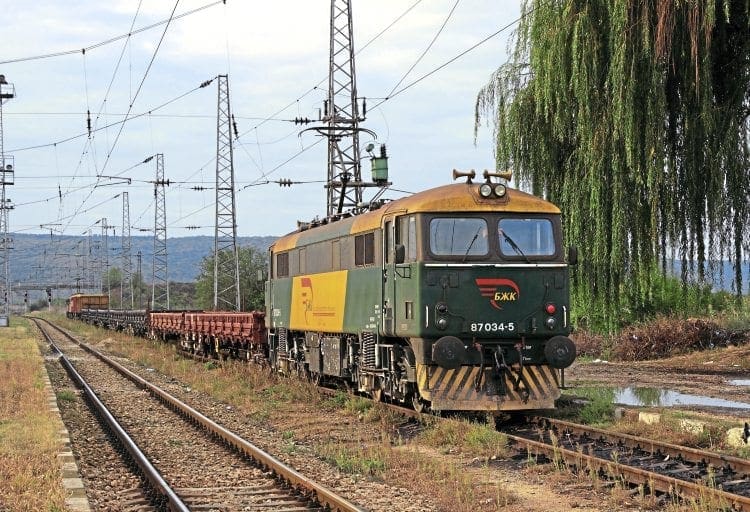
Summary:-
■ ACTS – 58038/9/44 (3) N.B. Subsequently transferred to France (LGV Rhin-Rhône).
Eastern Promise
From the mid-2000s, private concerns became increasingly involved in the facilitation of British motive power operating abroad, notably trading companies, leasing companies (ROSCOs [Rolling Stock Companies], such as Porterbrook and HSBC), and management companies (such as Europhoenix and their engineering arm Electric Traction Services).
In December 2006, ROSCO Porterbrook sold Nos. 87012/9 to BZK (literally translated Bulgarian Railway Company) via trading company Romic-Ace International; these two locomotives moved from Wembley to Bulgaria via the Channel Tunnel for trial purposes in December 2006, still retaining their Network SouthEast and LNWR black liveries, respectively.
Trials were evidently successful and the intention was to ship a further 25 Class 87s to Bulgaria. In the event, only 15 locos were transferred between
June 2008 and November 2009, making 17 in total, this being due to the adverse impact of the 2008 recession.
Of the additional 15, three were moved via the Channel Tunnel, and the remainder shipped via Hull, with, it is believed, barge transfer from Antwerp to Ruse.

Considerable preparation work on the 15 was undertaken by ETS (Electric Traction Services) at Long Marston, including the repainting of No. 87004 in BR blue livery and nine others in the green & yellow BZK livery. Nos. 87006/22/28 were transferred in their touched-up DRS/First dark-blue livery, and 87007/08 in Cotswold grey.
Final ‘Bulgarianisation’ was carried out at Koncar, Sofia, including the fitment of twin air pipes, wing mirrors, cow catchers, roof-mounted ‘Shrek’ air horns, roof-mounted lights, bodyside transformer access panels, and modified cab instrumentation.
The BZK fleet has, so far, never been provided with a second pantograph. Nos. 87012/19/22 are the only locomotives to have been repainted since arrival in Bulgaria, all in subtle variations of their as-exported liveries, 87012/19 as planned repaints, and 87022 following extensive fire damage.
No. 87014 has never worked in Bulgaria, and has resided at Koncar, Sofia since arrival in late 2009, while No. 87008 is also stored out of use following copper theft and is now used as a source of spares, already sitting on a pair of accommodation bogies.

The BZK Class 87s are based at Pirdop but operate extensively throughout Bulgaria. While their major flow is the Pirdop to Razdelna sulphuric acid tank traffic, they can also be found at such places as Burgas, Ruse, Dimitrovgrad, Ilyantsi, and Blagoevgrad.
The sulphuric acid trains are very impressive with two locomotives on the front of a 42-wagon consist, with a further ‘pusher’ loco on the rear. Unfortunately, for British enthusiasts, the lead loco is frequently a BZK Romanian-built Co-Co electric Class 40; as I understand it, the Class 40 lead loco preference comes from the superior adhesion characteristics of the Co-Co wheel arrangement.
The decision to restrict the BZK fleet to 17, rendered 11 Class 87 locomotives spare in the UK. Recessionary pressures suggested unforeseeable outlets for these locomotives and so seven surplus locos were scrapped at EMR Kingsbury. The ‘18th’ locomotive for BZK (87021) was already stripped down ready for refitting components and repainting; in this condition it was an immediate candidate for disposal.
However, four of the Class 87s in better condition (87009/17/23/25) were retained, with 87017/23 repainted in the Europhoenix livery for demonstration purposes.
These locomotives, now owned by Europhoenix, eventually found a home with another Bulgarian private operator, this time Bulmarket (БУΛMAPKET). These four were shipped on the m.v. Oostvoorne from Hull Docks on November 1, 2012 and discharged in Varna (Black Sea) on November 29, 2012; Class 86 No. 86233 was shipped at the same time as a source of spares, more of which later.
The four Bulmarket 87s were sent to Koncar, Sofia, for refurbishment. Minimal work was required on Nos. 87017/23 following initial work undertaken by ETS (the engineering arm of Europhoenix) at Long Marston and their overhaul was completed by March 2013.
Nos. 87009/25 were both exported in tatty Virgin livery and were originally thought by the railway enthusiast fraternity to be a source of spares; however, the ingenuity of the Bulmarket and ETS engineers prevailed and both have returned to traffic, although it took until February 2014 for Nos. 87025 to finally make it.

The Bulmarket Class 87s can be seen widely across Bulgaria hauling liquid petroleum gas trains, with Ruse, Varna, Dolno Ezerovo and Belozem being good locations to see them in action. Being only a four-strong fleet, they are harder to track down than the more numerous BZK fleet.
Bulmarket, always keen to acquire a good British asset, then turned its eyes to the Class 86s to further strengthen their fleet. No. 86233 (in Electric Blue livery) had already been acquired for spares for the Class 87s, and has lain dormant at Ruse Port since arrival. In April 2016, six Class 86s departed from Hull Docks on the m.v. Hoogvliet with discharge in Varna on May 3, 2016.
I will always remember seeing the six Class 86s being hauled from Varna Port to Razdelna in torrential rain, and then seeing them later stabled in a line in Razdelna Yard in glorious sunshine, with 87009 ‘up front’ ready to haul them to Ruse.
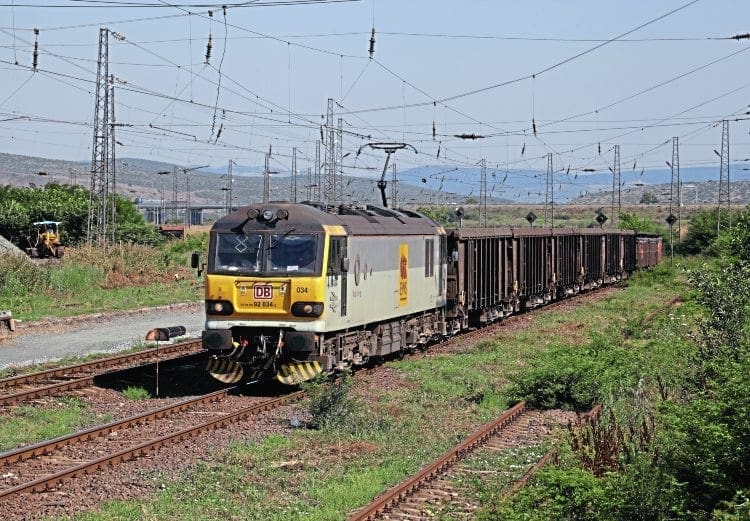
Four locomotives moved to the Express Service facility near Ruse for refurbishment, with two initially moving to Koncar, Sofia.
The latest news appears to be that all six will eventually return to traffic, subject to spares availability from the UK, even though 86231 and 86234 were originally thought to be for spares. In Bulgaria, the old adage ‘where there’s a will, there’s a way’ certainly applies.
Following refurbishment work, 86701/2 and 86213/35 are now in traffic working for Bulmarket. The locomotives have been renumbered due to the fact that the 86xxx series is already utilised by the ex-DSB (Danish State Railways) Class EA3000, operated by both DB and Bulmarket in Bulgaria; as a consequence Nos. 86701, 86702, 86213 and 86235 are now operating with the numbers 87701, 87702, 87703 and 87704, respectively.
These three locomotives carry the latest version of the Bulmarket livery i.e. grey and red. The Orion, Cassiopeia, The Lancashire Witch and Novelty names are retained.
Work on 86231 is progressing well at Express Service, Ruse and it is expected to become 87705. 86234 will, in all likelihood return to traffic in 2017 as 87706 following extensive engineering work by Express Service.
Summary:-
■ BZK – 87003/4/6-8/10/2-4/9/20/2/6/8/9/33/4 (17)
■ Bulmarket – 86213/31/3-5, 86701/2, 87009/17/23/5 (11)
Power Hungary
Between the Bulgarian BZK and Bulmarket Class 87 sales, Europhoenix sold eight Class 86s, previously bought from HSBC, to private-operator Floyd ZRt in Hungary. These eight were refurbished by ETS at Long Marston and exported to Hungary, via Immingham, between February 2009 and July 2013.
The EVM-102 signalling system, together with other local necessities, was fitted on arrival in Hungary. The locos were numbered in the series 450 001 to 450 008.
The first six locomotives were given an all-over black livery with a pink waist-line stripe and Floyd logos. The ‘Pink Floyd’ pseudonym was inevitable! With the acquisition of Floyd ZRt by Eurogate International in 2013, some livery modifications were applied, with the pink stripe replaced by half red/half-blue and revised Floyd logos applied. The last two locos of the operational fleet were delivered in this revised livery.
The first six locos were retrospectively modified to match. The class is currently in the throes of being further altered by the addition of a white bodyside panel above waist level and between the cab doors; 450 002/4/6-8 have so far received this livery version.
No. 86424, numbered 450 009 and still in all-over Network Rail yellow livery, has subsequently arrived in Hungary as a source of spares (August 2013).
It currently resides in Budapest Keleti depot.
Nos. 450 005 to 008 were despatched from the UK, fitted with twin pantographs, an operational insurance liked by Eastern European operators. As far as can be ascertained, 450 001 to 450 004 are still operating with a single pantograph.
Floyd has also taken delivery of three Class 56s from Europhoenix, two delivered in operational condition. No. 56101 (659 001) and 56115 (659 002) were exported in June and September 2012, respectively, from Immingham Docks after preparation at Nemesis, Burton, both in black livery with pink stripe.
Subsequent livery modifications, as per the Floyd Class 86s, have also been applied. No. 56117 (still in French Fertis livery) was exported from the UK in July 2013 as a source of spares. As 86424, this loco resides at Budapest Keleti.
Both the Floyd Class 86s and 56s operate a variety of traffic across Hungary, much of it spot-hire work. The Budapest to Hegyeshalom corridor is probably the richest vein for seeing these locos in action.
Even though No. 47375 is from the most numerous mainline British locomotive class and is also equipped with a Sulzer engine (common in Eastern Europe), it is perhaps the strangest British export.
This left the UK in October 2015 for a new life in Hungary with CRS (Continental Railway Solution), after preparation and repainting at Nemesis, Burton. The loco carries the CRS livery and the number 92 70 0047 375-5.
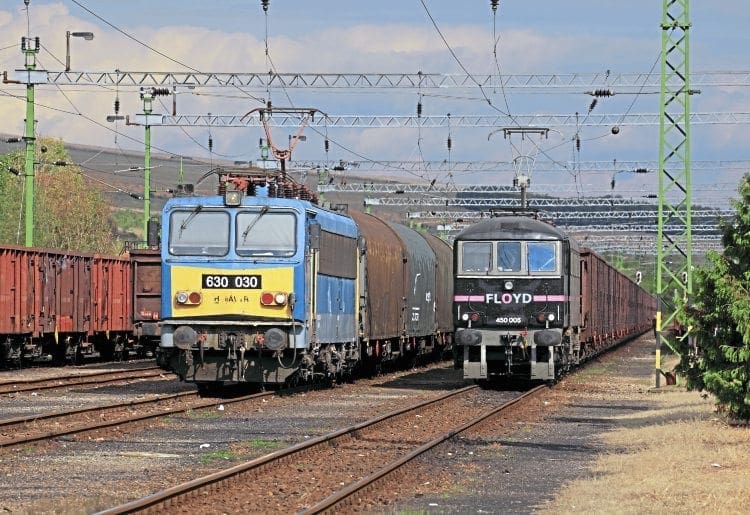
After a protracted stopover in Rotterdam, it finally arrived in Hungary in April 2016. As far as is known, this loco has yet to enter revenue-earning service in Hungary; however, Hungarian signalling equipment has been fitted and test runs were being undertaken west of Budapest during mid-November.
The locomotive was named Falcon on October 6, 2016 at Budapest Nyugati station.
Summary:-
■ Floyd – 56101/15/7 (3) N.B. 56115 and 56117 had previously worked in France (LGV Est). 86215/7/8/28/32/42/8/50, 86424 (9)
■ CRS – 47375 (1)
Improved asset utilisation
British freight traffic operations have progressively been taken over by multi-national operators and/or operators with multinational aspirations; this has led to a pan-European appraisal of activities and the drive for more effective utilisation of assets. As a consequence, under-utilised assets in one country are increasingly moving to other countries for use within the same overall company.
EWS actively pursued expansion into France from 2005. Nos. 66049 and 66083 moved abroad in May and October 2005, respectively, followed by 66215 and 66022 in January and June 2006, respectively, as a precursor to the squadron transfer of the Class 66s beginning in September 2006; all of them subsequently returned to the UK.
Ultimately, EWS moved 60 Class 66s to France (subsequently reduced to 59 with the transfer of 66220 to Poland) under the ECR (Euro Cargo Rail) operating umbrella. Although 66022/49 and 66215 ultimately became part of the French squadron fleet, 66083 never returned to France.
No. 66110 also paid a short visit to France in March/April 2007, ostensibly for wheelset tests. This EWS ‘expansionist’ initiative represented a decisive advantage in the decision by DB (Deutsche Bahn) to take over EWS activities in 2007 (operating as DB Schenker from 2009).
A downturn in coal and steel traffic in the UK during 2016 has led to the resumption of DB
Class 66s being redeployed in France, with five locomotives exported during October and November (66193, 66201/4/13/32).
DBS (DB Schenker) has moved 15 Class 66s to Poland (66220 in April 2010 [the ‘60th’ French loco] followed by a further 14 in the period March to September 2011).
DBS has also shipped 10 under-utilised Class 92s abroad, four to Bulgaria and six to Romania.
The 64 Class 66 operated by DBS/ECR in France frequently return to the UK (via the Channel Tunnel) for heavy maintenance at Toton TMD.
All 79 of the DBS Class 66 exports retain their original number, these also being incorporated into the UIC numbers. At least six of the Polish Class 66s were repainted into DB red livery (without yellow ends) as part of their initial ‘Polonisation’ preparation work in 2011.
The first DB Class 92 to move abroad was 92034 to Bulgaria in May 2012 under the auspices of
DB Schenker Rail Bulgaria, followed by 92025/7 in December 2012, and finally 92030 in July 2015. All four locomotives retain their as-built triple-grey livery, as well as the BR double-arrow logos, Crewe Electric depot diamonds and the Channel Tunnel roundels.
The original ‘transfer’ names on 92025/7/34 are also retained; 92030 also carries the Ashford transfer name, the previously fitted conventional nameplates having been removed prior to departure from the UK.
‘Bulgarianisation’ work was undertaken by Koncar, Sofia, including the fitment of twin air pipes, wing mirrors, new twin roof-mounted headlights, cowcatchers and Bulgarian signalling equipment. The Class 92s were built from new with two pantographs.
All four Class 92s are based at Pirdop and are heavily involved in the transportation of imported copper ore from the port of Burgas to the copper refinery at Pirdop.
They frequently operate in pairs, either with another Class 92 or with another imported class, the ex-DSB (Danish State Railways) Class EA3000 (now series 86012-20).
The Class 92 is usually the lead locomotive in mixed ex-DSB Class 86 and Class 92 pairings, further supporting the view that Co-Co traction is preferred for its superior adhesion performance.
The movement of DBS Class 92s to Romania started with 92012 in May 2013, followed by 92001 in July 2013. After a gap, 92002/24 departed the UK in April 2015 and 92005/39 in May 2015 (although the latter two spent some considerable time in Calais pending resolution of ‘transit issues’). ‘Romanianisation’ took place at the Softronic workshops in Craiova, including the fitment of twin air pipes, wing mirrors and the Romanian signalling equipment.

At the same time, locos were repainted in the DB red livery, although the BR double-arrow logos, Crewe Electric diamonds, and Channel Tunnel roundels have been retained, the exception being 92001, which had its BR and CE logos removed in the UK at the time of its repaint into EWS livery.
Locomotives have been externally renumbered into the series 472 001 to 472 006, although their original identities are still retained inside the cabs.
The Class 92s in Romania are exclusively deployed on freight trains and are, by definition, restricted to 25kV AC routes.
However, given the geographical size of Romania, the locomotives can be quite difficult to track down and in my experience these are the hardest locomotives abroad to pin-down comprehensively.
The principle route on which the locomotives are used is the west-to-east corridor from Curtici (near to the Hungarian border) to Constanţa (on the Black Sea coast) via Arad, Simeria, Târgu Jiu, Craiova, Caracal, Bucureşti and Feteşti.
However, the Class 92s can be found on a number of other routes, including Bucureşti to Braşov (via Ploeşti) and Braşov to Constanţa (via Ploeşti, Buzău and Ţăndărei).
The Curtici to Constanţa route alone is 600 miles long, with plenty of scope for ‘losing’ relatively slow moving freight trains, with further diversions to such places as Timişoara and Galaţi, complicating matters further.
The Class 92s appear to work turn and turn about with the other locomotives within the DB fleet, namely Classes 470 and 480 (‘Transmontana’), with extensive night-time operations.
The Class 92s appear to be well regarded by their operators although they are apparently relatively expensive to maintain compared to the indigenous locomotives within the DB fleet. The recent referendum vote for the UK to leave the EU and the impact that this is having on the value of the pound may exacerbate this problem further.
Freightliner has also shipped 16 Class 66s abroad with 10 of the Class 66/5 variant and six Class 66/6s moving to Poland (FPL), starting with 66586 in November 2008, to supplement their fleet of Class 66s. The latest three (of the 16) were shipped out of the UK as recently as March 2016.
All locomotives have been renumbered to fit the Freightliner FPL fleet series.
The last 10 exported retain their British number as part of their allocated UIC number (thus, the UIC number of 66013 is 92 70 066 411-4, reflecting its earlier life carrying 66411 in the UK).
The Freightliner Class 66s are progressively being fitted with roof-mounted, air-conditioning pods rendering them out of gauge in a British context.
Summary:-
■ DB (ECR France) – 66010/22/6/8/9/32/3/6/8/42/5/9/52/62/4/71-3, 66123/79/90/1/3/5, 66201-5/8-20/2-6/8/9/31-6/
9-47/9 (65)
N.B. 66220 subsequently transferred to Poland.
66083 (trial loco prior to squadron transfer; subsequently returned to the UK) (1)
66110 (wheelset testing In France in 2007; subsequently returned to the UK) (1)
■ DB (Poland) – 66146/53/7/9/63/6/73/8/80/9/96, 66220/7/37/48 (15)
N.B. 66220 previously worked in France (ECR).
■ DB Bulgaria – 92025/7/30/4 (4)
■ DB Romania – 92001/2/5/12/24/39 (6)
■ Freightliner (FPL) – 66411/2/7, 66527/30/5/82-4/6, 66608/9/11/2/24/5 (16)
The future?
Several years ago it was generally thought that the 24 Class 58s in France (plus other British motive power) would find use on forthcoming French LGV projects; a massive demand for motive power was forecast over the 2014-16 period for the more-or-less simultaneous work on the LGV Est (phase 2), LGV Sud Europe Atlantique (SEA), LGV Bretagne Pays de la Loire (BPR), and the Cournement Nîmes-Montpelier projects, a total of more than 600km of new construction.
Changed working methods on the LGV traces (greater deployment of road vehicles, plus the use of virtual ballast dumps), together with the availability of other surplus European motive power, has meant that the Class 58s still remain parked, gradually deteriorating, in a field at Alizay. Maybe HS2 beckons?
Further transfers of Class 66s and 92s by DB seem highly likely given the volume of locomotives made surplus by the recent downturn in coal and steel traffic in the UK. Nos. 66193, 66201/4/13/32 have recently moved to France for use under the ECR umbrella and more may follow. Nos. 92003/26, now allocated to the WGEE (Eastern Europe) pool, are currently in position for export being located at Dollands Moor.
Long term, further 25kV AC electrics to Bulgaria may be in the offing, thereby finding work for ultimately displaced Freightliner Class 86s and East Anglian Class 90s. All conjecture, of course!
Diesels represent a lesser potential market given the surfeit of power in Europe currently, but think of all those redundant 60s at Toton. Interestingly, at the time of writing, a further 20 Class 60s have been put up for sale by DB.
Perhaps it is too much to hope that these fine machines can ultimately find useful employment abroad. And, with new ownership arrangements, maybe the GBRf Class 66s will find alternative employment abroad?
Given the nature of the privatised railway, it is also likely that British locomotives already operating abroad will move again to reflect their owning company’s traffic demands.
There is already a precedent here with the movement of four ex-DSB Class EA3000 electric from Romania (as Class 465) to Bulgaria (as Class 86) in 2014/15. So, for example, the movement of Class 92s between Bulgaria and Romania is entirely possible if economic circumstances dictate.
The subject of British locomotive operation across Europe is a fascinating one which I hope this article illustrates.
Many enthusiasts seem to be somewhat ‘frightened’ of travelling abroad, away from the traditional tourist traps. It is true that people in many of the remote areas where British locomotives currently operate do not speak English, but there are other more subtle but very effective (even amusing) ways of communicating.
Most of my trips involved flying, then hiring a car to get to some fairly obscure destinations. Driving on the right was a slight challenge at first, but quickly became second nature. I would always recommend taking out fully comprehensive car insurance, and travelling in pairs, as strong navigation is essential.
‘Know the ropes’
Driving and navigating on your own when visiting a new country for the first time can be somewhat daunting. After having visited a country a couple of times and got to ‘know the ropes’, then I am quite happy travelling solo.
In the end, it’s all worth it. Meeting different and usually friendly people, experiencing different cultures, eating interesting food, and enjoying the scenery is all worthwhile, but the pleasure of seeing British traction in action abroad for me is second to none. It’s a whole new experience and definitely worth the effort.
There is no doubt about it, some of my most memorable railway experiences have occurred while travelling abroad. The PTG ‘Magnificent Seven to the Sea’ railtour in May 2010 gave three days of solid Class 87 haulage in superb Bulgarian weather, and was top notch.
Cab riding the CFPD Class 20s during the Along Different Lines ‘Choppers & Tractors’ tour in France in 1999, from Avallon to Autun, was very special.
From a pure task achievement point of view, getting photographs of my last two Class 92s in Romania following 22 hours of driving (shared between two of us) over two days last June was totally mad, but ultimately very satisfying. Walking among 41 resting Class 37s at Eurre base one morning in June 2000 was quite unbelievable.
However, I guess the best of all was the two hours spent on Tartaguille bank in France, again in June 2000, watching train after train of double-headed and double-tailed Class 37s hauling empty ballast trains, flogging their way up the incline to the tunnel when returning to Eurre base on the LGV Méditerranée: absolutely superb!
However, watching a multi-coloured rake of six Bulmarket Class 86s being shunted in Razdelna Yard last May within hours of their arrival in Bulgaria comes a very close second! All fantastic memories!
Acknowledgements.
Much of the article has been assembled through personal observations and information derived from many contacts with people ‘in the know’ over the years, supplemented by ‘trainspotting’ images on the worldwide web, particularly ‘flickr’, for additional information concerning latest locations and liveries of particular locomotives. The author would particularly like to acknowledge help from wnxx.com concerning locomotive departure dates from the UK.
The Railway Magazine Archive
Access to The Railway Magazine digital archive online, on your computer, tablet, and smartphone. The archive is now complete – with 121 years of back issues available, that’s 140,000 pages of your favourite rail news magazine.
The archive is available to subscribers of The Railway Magazine, and can be purchased as an add-on for just £24 per year. Existing subscribers should click the Add Archive button above, or call 01507 529529 – you will need your subscription details to hand. Follow @railwayarchive on Twitter.




